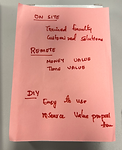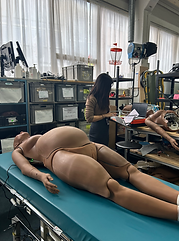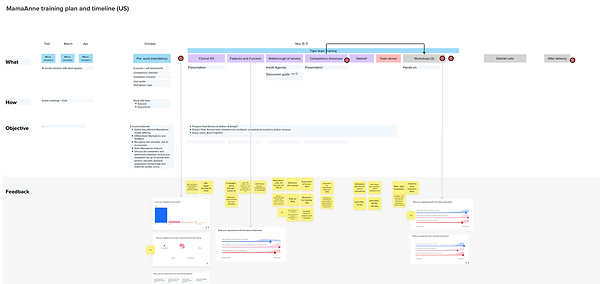Revamping services
Making process collaborative and insight driven*

*Note: Business sensitive information has been restrained, hence limited artefacts and details are shared
Laerdal Medical has been offering Educational and Technical services for their high-end simulators for some years. With the launch of the new birthing simulator the aim was to revamp the services to offer a holistic solution that better meets customer needs.
Breaking the Mold Without Breaking the Flow
- The work required many siloed teams to collaborate, each with different priorities
- Deadlines had to be met, so there was a challenge to reimagine while delivering
- Major challenge was to get different stakeholders to see the need for change and get them to commmit to it
- There was a need to not just change what we deliver, but how we work together
The project involved stakeholders from services team, hardware product team, user information team, digital platform solutions team, Regional services delivery teams
Major responsibilities
- Enable collaboration across teams
- Facilitate co-creating and implementing change
- Coordinate parts to design a coherent whole
exploration
creation
reflection
implementation
(Stickdorn Service Design Process, 2012)
- Services vision workshop
- Cross-functional alignment and ideation
- Education services ideation
- Customer journey
- Services mapping
- e-course prototypes
- Good service scale
- Impact mapping
- Prototype testing
- Retrospectives
- Training plans
- Micro learning sessions
- Feedback loops
Major tasks conducted during the project
Jan 2024
Feb 2025
"We need this for every product !"
- Lead Designer, User information team working on product resources (Feedback after a workshop)
Aligning on Intended impact
To design new, it was key to get the team to reflect on the current state. I facilitated a workshop to self-assess our services, align on our vision and the intended impact. It was to start establishing a collective understanding of services, both educational and technical services.
I presented customer insights from past research on services, existing dashboards on post-service surveys, and customer testimonials. The intention was to bring the team closer to customer pains and gains when assessing and reflecting on our deliveries.

The essence and the details
How good is our service?



Everyone in the team reflected on which phases of the customer lifecycle do we have direct and indirect impact on today and where ideally we should have impact.
Then the group had to dicuss and act out how they think our services look today, and the observers reflecte don
In addition, everyone individually assessed our current services on the Good Services scale. (modified).This highlighted both our weak areas but also dissonance in the team.
What is the value we provide?
I followed this with a vision revision workshop - and further elaborate what that means for the team. Then tasked the team with a "cereal box" workshop to capture the essence of services : what is the offering, the ingredients and value.


Building together, producing shared value
Leading together - with other service-designers
I collaborated with the Service designer from the product team to map the future customer journey, aided with storyboarding to shift the focus to customer experience from individual deliveries.
We facilitated a workshop to get teams to ideate together to improve the journey.
Different teams understood the product together and what customers are expecting from it. Then, with the focus on different users, ideated on the future journey for them. Service prototypes were presented as new imagined user journeys. The prompts for ideation were the qualitative value we want users to have at each point. This was also to serve as our success metrics.
Ideas were mapped across the journey and then prioritised to be worked on.
What value we want user to have at each point?




Imagining new journeys
This enabled
-
Aligned understanding of the customer journey
-
Shift from single touchpoint to service experience for multiple users
-
Co-design and collective decision making
-
Concrete and realistic actions for improved experience within the project timeframe
The workshop was effective, which led to a gallery walk and ideation workshop with the digital ecosystem team reflecting on the journey and committing to an improved digital experience.
Desingning in iterations, testing often


Based on the input from the workshop, the services team defined what onboarding means and what learning outcomes we want to meet.
I then worked closely with the learning specialist and ed-services developer in my team to design new concepts for the e-learning, moving the focus from product features to training scenarios, a shift towards learning by doing. I created a prototype for the course, which was tested with different personas for feedback on the learning experience.
It was tested in context, also along with the user guide to find overlaps and avoid duplication. The course was iterated based on the insights.
Apart from offering an improved course, the aim was to make the development process iterative and feedback-driven. This was pushed as a way of working throughout the development process like the technical checklists were tested along with the product during beta testing.
Making it holistic
Case of Consistency
The before and the after...
Different regions offer the same service differently. The service teams supported the regions with key resources but eveything in between and around was not a focus. This meant inconsistency in customer experience and inadequate support for the internal stakeholders.
Mapped existing touchpoints to capture best practices across different regions, and why those exists, what works and what doesn’t.
There were key areas of improvement identified - around data collection, services and sales alignment, communication resources and digital ecosystem literacy, which were beyond learning resources.

How are different regions putting the pieces together?

Thinking as a service :
Moving from isolated resources to learning journeys

leveraging enagement for better outcomes
The team had been continuously improving learning resources but we saw a gap in intended and achieved impact. One of the key reasons was the focus on independent resources in isolation. Adoption of e-learning was another goal to be met.
Building on past workshops, I facilitated a session with education services developers and service designers on product and digital ecosystem to ideate on different actions for intended outcomes across the learning journey.
The nudge was to leverage high engagement instances and, thinking about both end learners and internal educators.
This led to newer methods for trainings, service checklists, and templates.
Building standards for training


feedback loops
Mapping training plan for standardising
One of the key deliverables was training internal personnel on the product. There weren't defined training processes - and I also sensed a need to a plan to be mapped as different stakeholders were working on different touchpoints and there wasn't clarity on responsibilities.
I also took the opportunity to set a template for planning a training and nudged the team to use the first training for a selected group as a pilot for future trainings. Feedback channels were established and post-delivery retrospective was conducted for further improvement.
In addition, I also supported the education services developer in creating micro learning sessions, something new that we tried in line with low dose-high frequency training and to prime the field services team.
Some wins from the project
-
Improved touchpoints
-
Multiple initiatives in motion
-
Scenario based e-learning
-
Thinking in Learning paths
-
Established standards and feedback loops for internal training
Bigger wins
-
Getting people to work together
-
Nudge for continued changes
-
Setting the stage for future collaborations

